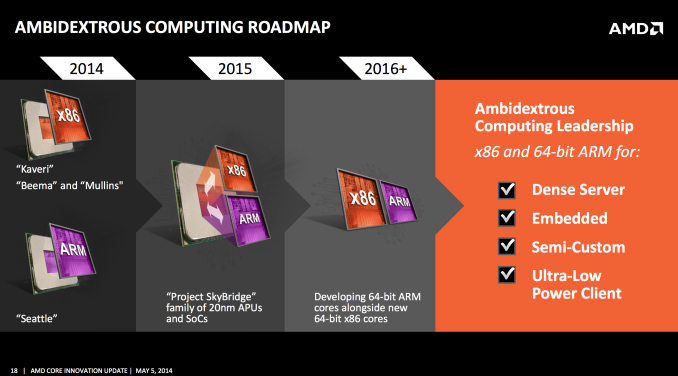AMD is also working on a new 64-bit x86 Core
by Anand Lal Shimpi on May 5, 2014 1:16 PM EST
Jim Keller joined Mark Papermaster on stage at AMD's Core Innovation Update press conference and added a few more details to AMD's K12 announcement. Keller stressed AMD's expertise in building high frequency cores, as well as marrying the strengths of AMD's big cores with those of its low power cores. The resulting K12 core is a 64-bit ARM design, but Jim Keller also revealed that his team is working on a corresponding 64-bit x86 core.
The x86 counterpart doesn't have a publicly known name at this point, but it is a new design built from the ground up.










112 Comments
View All Comments
coburn_c - Monday, May 5, 2014 - link
Less staff than ever, farther behind than ever, and now they will split their resources...bji - Monday, May 5, 2014 - link
That's OK. x86 performance increases have slowed to the point where it's not as hard to catch up. AMD will reach performance parity with Intel sometime within the next 2 - 3 years because it will cost Intel more than the market can bear to stay ahead of AMD. It's already costing more than the market can bear to significantly increase x86 speeds, which is why the x86 performance increase curve is flattening out (witness the stagnation in single core performance increases in the past 2 - 3 years).coburn_c - Monday, May 5, 2014 - link
Lack of competition is the cause of the performance malaise.eanazag - Monday, May 5, 2014 - link
Lack of competition from a CPU performance perspective. There has been clear and measurable advances in power efficiency. AMD is behind in process technology, which has always been an issue. AMD has been behind in other technologies such as High K metal gates and finfet blah blah 3d transistors where Intel has had a lead in.Telling me AMD will be caught up in 2-3 years has not ever in the past and likely will not ever take place. Pointless optimism.
MikeMurphy - Monday, May 5, 2014 - link
^ and amazingly they still manage to sell products that I'd like to buy. The high-end APUs are really impressive and a lot of fun to tune. The new affordable Kabini / Beema architecture is an excellent platform affordable NUCs, basic computing and some light duty HTPC work. Intel is an efficiency king but doesn't service all parts of the market well.PEJUman - Monday, May 5, 2014 - link
as an owner of i7-4770K and A10-7850K, I can say both are equally fun to tinker around.Yes, the A10 is impressive if viewed sans intel, but the only reason I bought the kaveri is because microcenter is selling it for $130. at the 190 or so MSRP, I would've gone elsewhere.
I also have the A6-1450 laptop which is amazingly good for the price, but again, price being the key-word here. I much rather have competitive AMD designs at comparable price/profit margin with intel. It is hard to build a sustainable business based on low prices...
Gizmosis350k - Wednesday, May 7, 2014 - link
Intel needs competition but as we can see AMD is hellbent on making each transistor the size of JupiterMartinT - Monday, May 5, 2014 - link
I'd be more easily convinced on that if AMD had shown any sign of catching up since the Summer of 2006.calyth - Monday, May 5, 2014 - link
So what's your usage patterns that requires a super-fast CPU nowadays. My game of Bioshock Infinite didn't hiccup when I use an A10 - 5800K when paired with a real graphics card, and it's plenty fast for video conversion.MadAd - Monday, May 5, 2014 - link
rofl, are you gonna tell us you only ever fit $1000 intel chips in your boxes? AMD have been price/performance compatible in many of their generations since 2006, all except very high end.